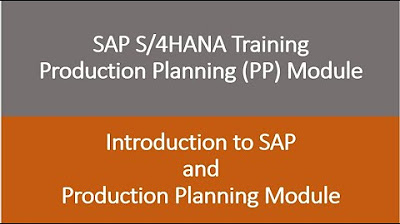The EVOLUTION of ERP | @SolutionsReview Explores (#ERPInsightJam)
Summary
TLDRIn this episode of Solutions Review Explores, host Jonathan Paula delves into the history and evolution of Enterprise Resource Planning (ERP) systems. ERP began in the 1960s with centralized computing for inventory management, evolving through the decades to include various business processes like manufacturing, HR, and distribution. The 1980s saw the introduction of MRPII, focusing on manufacturing optimization. By the 1990s, ERP systems became more adaptable, supporting open architecture and customization. Today, modern ERP systems are agile and integrated, aiding businesses in responding flexibly to changing demands. For more, visit SolutionsReview.com.
Takeaways
- 📈 ERP software unites, streamlines, and standardizes business processes across various departments of a company.
- 📅 The term 'ERP' was officially coined by Gartner Inc. in 1990, but its origins trace back to centralized computing systems in the 1960s.
- 🏗️ Material Requirements Planning (MRP) systems were developed in the 1970s, focusing on planning product or part requirements based on production schedules.
- 🔗 ERP systems evolved to integrate business processes like manufacturing, distribution, accounting, and human resources, improving accessibility and visibility across enterprises.
- 🛠️ In the 1980s, Manufacturing Resource Planning (MRPII) was introduced to optimize manufacturing by synchronizing materials with production.
- 🔄 Early ERP systems often required companies to reengineer their business processes to fit the software, which was a significant challenge.
- 🌐 By the 1990s, ERP systems evolved to support open architecture, modularity, and customization, adapting to more complex business environments.
- 📊 ERP add-ons like Advanced Planning Systems (APS), Customer Relationship Management (CRM), and Supply Chain Management (SCM) became popular in the 1990s.
- 🚀 Modern ERP systems now cover a complete suite of back-end and front-end business operations, with broader capabilities and deeper integration.
- ⚡ According to Deloitte, ERP is shifting from strict process automation to a more agile framework for better response to changing business conditions.
Q & A
What is the purpose of ERP software?
-ERP software is designed to unite, streamline, and standardize business processes across different departments within a company.
When was the term 'ERP' first coined?
-The term 'ERP' was officially coined by Gartner Inc. in 1990.
What was the primary use of centralized computing systems in the 1960s?
-In the 1960s, centralized computing systems were primarily used for inventory management.
What does MRP stand for and when were these systems developed?
-MRP stands for Material Requirements Planning, and these systems were developed in the 1970s.
How did MRP capabilities lead to the emergence of ERP systems?
-After the emergence of MRP capabilities, ERP systems began integrating business processes, including manufacturing, distribution, accounting, financial, human resource management, project management, inventory management, service, and maintenance, and transportation.
What was the focus of manufacturing resource planning, or MRP II, introduced in the 1980s?
-MRP II emphasized the optimization of manufacturing processes by synchronizing materials with production requirements.
What challenges did early ERP systems face regarding customization?
-Early ERP systems were seen as one-size-fits-all solutions that forced companies to reengineer their business processes to accommodate the logic of the software modules.
What changes did the ERP industry implement in the 1990s to improve systems?
-In the 1990s, the ERP industry recognized the importance of open architecture, interchangeable modules, customization, and user interfacing.
What additional add-ons and extensions became popular in the 1990s?
-In the 1990s, add-ons and extensions such as Advanced Planning and Scheduling (APS), Customer Relationship Management (CRM), and Supply Chain Management (SCM) gained popularity.
How have modern ERP systems evolved in terms of business operations?
-Modern ERP systems have evolved to encompass the complete suite of back and front-end business operations, with an increase in the number of vendors, range of solutions, and broadening and deepening of applications' capabilities.
What does Deloitte highlight as the most significant change in ERP systems?
-Deloitte claims the most significant change in ERP systems is the shift from strict process automation based on scale and repetition to an orchestration framework for agile, adaptable responses to often-changing events.
Outlines

Dieser Bereich ist nur für Premium-Benutzer verfügbar. Bitte führen Sie ein Upgrade durch, um auf diesen Abschnitt zuzugreifen.
Upgrade durchführenMindmap

Dieser Bereich ist nur für Premium-Benutzer verfügbar. Bitte führen Sie ein Upgrade durch, um auf diesen Abschnitt zuzugreifen.
Upgrade durchführenKeywords

Dieser Bereich ist nur für Premium-Benutzer verfügbar. Bitte führen Sie ein Upgrade durch, um auf diesen Abschnitt zuzugreifen.
Upgrade durchführenHighlights

Dieser Bereich ist nur für Premium-Benutzer verfügbar. Bitte führen Sie ein Upgrade durch, um auf diesen Abschnitt zuzugreifen.
Upgrade durchführenTranscripts

Dieser Bereich ist nur für Premium-Benutzer verfügbar. Bitte führen Sie ein Upgrade durch, um auf diesen Abschnitt zuzugreifen.
Upgrade durchführenWeitere ähnliche Videos ansehen

What is ERP Software? Here is everything you need to know.

Apa Itu ERP? History, Manfaat, Fitur dan Tips Memilih Vendor ERP!

Mau Implementasi Sistem ERP Anda Sukses? Pahami Dulu Hal-hal Dasar Tentang Sistem ERP Berikut Ini

Video 01 - SAP S/4HANA Production Planning (PP) Module training - Introduction to SAP and PP

Enterprise Resource Planning (ERP) in 15 minutes

Materi Enterprise - Mengenal Software ERP
5.0 / 5 (0 votes)
